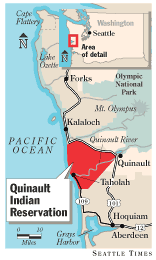 |
 |
 |
| Your account | Today's news index | Weather | Traffic | Movies | Restaurants | Today's events | ||||||||
|
December 5, 1996
Minding the rules, making them work
Highway 109 along the Washington coast is the only road into Taholah, heart of the Quinault Indian Reservation. It's the road Wilson has used to get to work nearly every day for more than 20 years. That work is evident everywhere, and in fact, is responsible for much of what constitutes Taholah. Wilson, a Quinault born and raised on the reservation, has run her tribe's housing authority for the past two decades.
Using grant money from the U.S. Department of Housing and Urban
Development, she has administered the construction of more than 200
houses — roughly two-thirds of the homes on the reservation.
Under her leadership, the Quinault Indian Housing Authority has built safe, modest, low-cost homes for low-income tribal members. It has had no scandals, no unpaid debts and no indications of fraud - no small accomplishment in the current climate of HUD's Indian-housing program. As The Seattle Times discovered in a national investigation of the program, tribal-housing authorities across the country have taken advantage of HUD's new relaxed approach to regulation. While the new policy was designed to give tribes more freedom, abuses have run rampant, with tribal officials using tax money to build themselves huge houses and to benefit a favored few at the expense of those more needy. Not in Coni Wilson's program, whose history demonstrates that the federal Indian-housing program can work. But even Wilson is discouraged about the program these days, as she, too, gets pressure to bend rules. Jan Engle, a senior analyst in the Seattle office of HUD's Indian-housing program, described Wilson as strict, fair-minded, and more loyal to rules than even to family. "It didn't matter if the situation involved a relative of hers or someone else — she applied the rules the same," Engle said. "I've heard her family say that she applies the rules tougher to them." Records show Wilson indeed has taken action against two relatives, evicting both a nephew and a cousin from HUD housing in two separate incidents for not paying rent. Of course, her adherence to rules has made her a few enemies on the reservation. Among them are tribe members wanting undue personal benefits, and those who have run up against her uncompromising will. Now a couple of her detractors sit on the tribe's housing board, which oversees Wilson and her staff. Her relations with the board during the past two years, she says, have been strained. Wilson has tried to resign twice. She plans to retire in October. Publicly, she says she wants to pursue other interests. Privately, she says she's disheartened by abuses of the housing program elsewhere and by the pressure from people on her reservation.
She believes in the program, and worries for its future. Look
what it did for Taholah, she will tell you. With little prompting,
she'll give you a tour of the entire village and the changes she has
seen.
Highway 109 winds along the Olympic Peninsula coastline, threading between lush green hills to the east and crashing surf to the west. Wilson lives a few miles south of Taholah, off the highway, in a yellow two-story house she bought in 1977 for $43,500. Out front is her decades-old Ford pickup, powder blue and not so reliable anymore. In good weather, she rides her bike to work. On the rainy Peninsula, most days that means she catches the 7:30 a.m. county-transit bus to Taholah. The village sits at the mouth of the Quinault River, a green ribbon of life that has sustained the tribe for centuries. The Quinaults historically were a salmon-fishing people, numbering between 2,000 and 3,000 at the time of first contact with European explorers. By the late 1800s, as a result of white incursion and disease, the Quinaults numbered a mere 102. For much of this century, Taholah has been little more than a subsistence settlement, a seaside collection of stick-built homes along three gravel streets. Wilson was born and raised in one of those houses, her grandmother's, which she remembers as having "three rooms, three bare light bulbs, one cold-water faucet and an outhouse." She likes to start the tour here, at the site of her grandmother's old house, near the old center of town, and then to walk in a widening spiral toward the newer parts of the village. Taholah now has 700 residents living in three subdivisions, with more than a dozen paved streets, sidewalks, a sewer system, and water and electricity in every house. All these improvements were paid for by HUD. The houses are simply designed, modest in appearance if not downright boxy, although some of the newer ones have a little more flair. Certainly, there is nothing extraordinary about them — none of the sprawling estates, Jacuzzis and three-car garages found on other reservations. Wilson takes pride in the very ordinariness of her housing developments. They are a contrast, almost a rebuke, to the extravagances of other tribes. At 50, Wilson is the matriarch of Indian housing in the Northwest. She knows all about abuses, including the 5,300-square-foot house built by and for her counterpart on the Tulalip Indian Reservation in Snohomish County. Her voice grows tense when she talks of it. Her jawline tightens, and her eyes seem to widen and darken at the same time, like a cat under threat. Wilson believes that when HUD money is spent on extravagance, it's stolen from the poor. With more than 100,000 Indian families nationwide in need of homes, including 5,000 in the Northwest, she sees no justification for diverting low-income-housing money for anything else. In her own tribe, 250 families are on a waiting list for a HUD home. The typical wait is about three years, although many wait longer. A story of two women The story of housing on the Quinault reservation is really the story of two women, Elizabeth Cole and Coni Wilson, mother and daughter, Bunny and Little Bunny, as close friends know them. Before Wilson, there was Cole — the only other housing director the tribe has had. She started the program and ran it for eight years, when the first 20 HUD houses on the reservation were built. In 1976, she stepped down after suffering a heart attack. Today, Cole lives in a small house just a few yards from the site of her mother's old house and Wilson's birthplace. At 78, she is a smaller, bespectacled version of Wilson, with the prim demeanor of a Sunday-school teacher — which for many years she was. "That's my guide," she will tell you, pointing to a big black King James Bible on her coffee table. When she was younger, Cole, a Pentecostalist, attended church five times a week and made sure all eight of her kids did, too. When asked how daughter Coni has managed to keep such a tight ship at the housing authority — despite temptations to do otherwise — Cole said: "I taught all my kids to hold fast to what is right and good in the sight of God and man." "If we didn't, she swung the belt," Wilson added. Cole smiled a Sunday-school smile. Wilson: "If I used HUD money to build myself a big house, first, I'd have to look at myself in the mirror. Second, I'd have to face my mother." When Cole stepped down from the director post, Wilson — who'd been the agency's rent-collector — took over as director, but with reluctance. She says she didn't want the job but felt pressure from her mother: "I twisted her arm, almost broke it," Cole said. "And her head, too." That was in 1976. The rest is history, with Wilson taking the reins and not looking back. She's become not only a leader among the Quinaults, but also a regional and national advocate for Indian housing. She's held positions on the Governor's Affordable Housing Committee, the National American Indian Housing Council and the Northwest Indian Housing Association. Last month, she was chosen to be part of a national committee assigned to draw up the rules for a newly passed law that will dramatically change how Indian-housing money is distributed. The committee starts work next week. "People have come to know Coni as someone who has the welfare of Indian housing at heart," said Ruth Jaure, executive director of the National American Indian Council in Washington, D.C. "She really wants to do something for her people, and it's a very sincere commitment." A bitter departure Twenty years, a thousand hours of lobbying, three subdivisions, miles of sewer and electrical lines, 200 houses and 12 paved streets later, Wilson is ready to call it quits. It's been a difficult year. The tribe is still poor. Nearly 80 percent of all tribal members earn $15,000 or less, with 80 families on the reservation making less than $5,000 annually. More than a hundred homes have serious problems with foundations, roofs or plumbing. And more than 60 families are doubling or tripling up in houses meant for one family. So when the last batch of 20 HUD houses was built on the reservation last year, a great clamor arose over who would get them. Two new housing-board members lobbied hard to get houses for members of their own families — members who were not at the top of the waiting list. Wilson protested. "Some of the board members just don't understand their roles," she said. They're supposed to look after the interests of the whole tribe, not just their relatives. There was yelling and name-calling. Eventually the board members, who technically are Wilson's bosses, won. One board member got houses for a brother and sister; another got houses for three of her children. HUD had no say on the matter, Wilson said. Such situations are considered part of sovereign tribal domain, and out of the federal government's jurisdiction. Wilson turned in her resignation last December and bitterly left the reservation. But with her staff foundering without her, she returned. In April, she resubmitted her resignation, but eventually agreed to stay on until a new director is found. Her target date to quit is Oct. 1, 1997. At the end of her workday, Wilson catches the 4:50 p.m. bus out of Taholah. The bus passes clusters of houses. She knows every house, and every person inside. That's her work they're living in. Twenty years worth of work, affecting hundreds of lives and permanently changing the shape of her reservation.
It's enough to make a mother proud. Whatever happens, Wilson
will always have that.
|
|
|||||||||||||||||||||||||||||||||||||||||||||||
seattletimes.com home
Home delivery
| Contact us
| Search archive
| Site map
| Low-graphic
NWclassifieds
| NWsource
| Advertising info
| The Seattle Times Company


